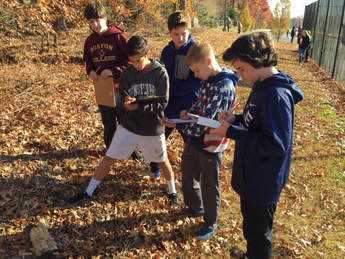Systemic Sustainability: 1.1 Curriculum and Instruction
 An science class making observations.
An science class making observations.
Environmental Literacy Instruction
Environmental Literacy is a school system graduation requirement, with curriculum components at all grade levels, and alignment with state requirements and Common Core. It includes objectives for students to engage in outdoor learning annually, making a literal connection to the environment in which they live, inspiring them to learn and grow in their understanding and commitment toward caring for the natural world around them. At SPMS, these minimum grade level standards are far exceeded!
SPMS appreciates the mission established by Arlington Echo, the Outdoor Learning Center and leader for environmental education within AACPS.
As such, SPMS staff have embraced the duty and recognize that the school’s position within the Chesapeake Bay Watershed affords unique learning opportunities to extend the classroom and bring the lessons to life through hands-on and outdoor instruction, ranging from raising terrapins, to planting rain gardens, to field trips that allow for further direct application.
Since 2011, when SPMS was first awarded the Maryland Green School designation, greater efforts and emphasis have been placed on incorporating environmental instruction across all curriculum. “Green School” is a theme that is woven into lessons in all subjects and at all grade levels. Not seen as merely a matter of science, environmental instruction is alive and well among the Severna Park Ospreys!
As part of 6th grade science, students conduct the Chesapeake Bay Foundation’s Schoolyard Report Card. This helps establish a strong foundation for understanding the concepts and their own direct connection to the matters affecting the Chesapeake Bay. From there, it is natural to further explore these ideas in all subject areas and years of learning at SPMS.
SPMS employs a team model, in which students are members of a team led by teachers, one from each subject area, as well as encore teachers and departments such as foreign language and special education. And in keeping with the green school mindset, most team names are environmentally oriented, such as blue herons, terrapins, and Marylanders. Teachers work together to reinforce concepts throughout classes, allowing students to see topics in different lights and through varied application. For example, while students investigate species of the Chesapeake Bay in science, they may arrive in social studies class later in the day and learn about the impact of the industrial revolution on the environment. The idea is taken in a different direction in language arts class where they must write position papers, as well as business letters and are challenged to do so with respect to environmental issues, again bearing in mind the watershed species and habitat. Through this collective approach, students are well positioned to attain environmental literacy at SPMS.
Environmental Literacy is a school system graduation requirement, with curriculum components at all grade levels, and alignment with state requirements and Common Core. It includes objectives for students to engage in outdoor learning annually, making a literal connection to the environment in which they live, inspiring them to learn and grow in their understanding and commitment toward caring for the natural world around them. At SPMS, these minimum grade level standards are far exceeded!
SPMS appreciates the mission established by Arlington Echo, the Outdoor Learning Center and leader for environmental education within AACPS.
As such, SPMS staff have embraced the duty and recognize that the school’s position within the Chesapeake Bay Watershed affords unique learning opportunities to extend the classroom and bring the lessons to life through hands-on and outdoor instruction, ranging from raising terrapins, to planting rain gardens, to field trips that allow for further direct application.
Since 2011, when SPMS was first awarded the Maryland Green School designation, greater efforts and emphasis have been placed on incorporating environmental instruction across all curriculum. “Green School” is a theme that is woven into lessons in all subjects and at all grade levels. Not seen as merely a matter of science, environmental instruction is alive and well among the Severna Park Ospreys!
As part of 6th grade science, students conduct the Chesapeake Bay Foundation’s Schoolyard Report Card. This helps establish a strong foundation for understanding the concepts and their own direct connection to the matters affecting the Chesapeake Bay. From there, it is natural to further explore these ideas in all subject areas and years of learning at SPMS.
SPMS employs a team model, in which students are members of a team led by teachers, one from each subject area, as well as encore teachers and departments such as foreign language and special education. And in keeping with the green school mindset, most team names are environmentally oriented, such as blue herons, terrapins, and Marylanders. Teachers work together to reinforce concepts throughout classes, allowing students to see topics in different lights and through varied application. For example, while students investigate species of the Chesapeake Bay in science, they may arrive in social studies class later in the day and learn about the impact of the industrial revolution on the environment. The idea is taken in a different direction in language arts class where they must write position papers, as well as business letters and are challenged to do so with respect to environmental issues, again bearing in mind the watershed species and habitat. Through this collective approach, students are well positioned to attain environmental literacy at SPMS.
